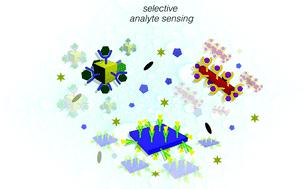当前位置:
X-MOL 学术
›
Mater. Horiz.
›
论文详情
Our official English website, www.x-mol.net, welcomes your feedback! (Note: you will need to create a separate account there.)
Harnessing selectivity in chemical sensing via supramolecular interactions: from functionalization of nanomaterials to device applications
Materials Horizons ( IF 13.3 ) Pub Date : 2021-08-16 , DOI: 10.1039/d1mh01117k Rafael Furlan de Oliveira 1 , Verónica Montes-García 1 , Artur Ciesielski 1 , Paolo Samorì 1
Materials Horizons ( IF 13.3 ) Pub Date : 2021-08-16 , DOI: 10.1039/d1mh01117k Rafael Furlan de Oliveira 1 , Verónica Montes-García 1 , Artur Ciesielski 1 , Paolo Samorì 1
Affiliation

|
Chemical sensing is a strategic field of science and technology ultimately aiming at improving the quality of our lives and the sustainability of our Planet. Sensors bear a direct societal impact on well-being, which includes the quality and composition of the air we breathe, the water we drink, and the food we eat. Pristine low-dimensional materials are widely exploited as highly sensitive elements in chemical sensors, although they suffer from lack of intrinsic selectivity towards specific analytes. Here, we showcase the most recent strategies on the use of (supra)molecular interactions to harness the selectivity of suitably functionalized 0D, 1D, and 2D low-dimensional materials for chemical sensing. We discuss how the design and selection of receptors via machine learning and artificial intelligence hold a disruptive potential in chemical sensing, where selectivity is achieved by the design and high-throughput screening of large libraries of molecules exhibiting a set of affinity parameters that dictates the analyte specificity. We also discuss the importance of achieving selectivity along with other relevant characteristics in chemical sensing, such as high sensitivity, response speed, and reversibility, as milestones for true practical applications. Finally, for each distinct class of low-dimensional material, we present the most suitable functionalization strategies for their incorporation into efficient transducers for chemical sensing.
中文翻译:

通过超分子相互作用利用化学传感的选择性:从纳米材料的功能化到设备应用
化学传感是科学和技术的一个战略领域,最终旨在提高我们的生活质量和我们星球的可持续性。传感器对幸福感产生直接的社会影响,包括我们呼吸的空气、我们喝的水和我们吃的食物的质量和成分。原始的低维材料被广泛用作化学传感器中的高灵敏度元素,尽管它们对特定分析物缺乏固有的选择性。在这里,我们展示了使用(超)分子相互作用来利用适当功能化的 0D、1D 和 2D 低维材料的选择性进行化学传感的最新策略。我们将讨论如何设计和选择的受体通过机器学习和人工智能在化学传感方面具有颠覆性的潜力,其中选择性是通过设计和高通量筛选大型分子库来实现的,这些分子库表现出一组决定分析物特异性的亲和参数。我们还讨论了实现选择性以及化学传感中其他相关特性的重要性,例如高灵敏度、响应速度和可逆性,作为真正实际应用的里程碑。最后,对于每一类不同的低维材料,我们提出了最合适的功能化策略,将它们结合到用于化学传感的高效换能器中。
更新日期:2021-08-23
中文翻译:

通过超分子相互作用利用化学传感的选择性:从纳米材料的功能化到设备应用
化学传感是科学和技术的一个战略领域,最终旨在提高我们的生活质量和我们星球的可持续性。传感器对幸福感产生直接的社会影响,包括我们呼吸的空气、我们喝的水和我们吃的食物的质量和成分。原始的低维材料被广泛用作化学传感器中的高灵敏度元素,尽管它们对特定分析物缺乏固有的选择性。在这里,我们展示了使用(超)分子相互作用来利用适当功能化的 0D、1D 和 2D 低维材料的选择性进行化学传感的最新策略。我们将讨论如何设计和选择的受体通过机器学习和人工智能在化学传感方面具有颠覆性的潜力,其中选择性是通过设计和高通量筛选大型分子库来实现的,这些分子库表现出一组决定分析物特异性的亲和参数。我们还讨论了实现选择性以及化学传感中其他相关特性的重要性,例如高灵敏度、响应速度和可逆性,作为真正实际应用的里程碑。最后,对于每一类不同的低维材料,我们提出了最合适的功能化策略,将它们结合到用于化学传感的高效换能器中。



























 京公网安备 11010802027423号
京公网安备 11010802027423号